The importance of nut trees to the edible landscape can’t be overstated. They’re beautiful, hardy, and provide easy protein. But their importance to the ecosystem is even greater, providing food and habitat for other creatures as well, especially if they happen to be native to the greater United States.
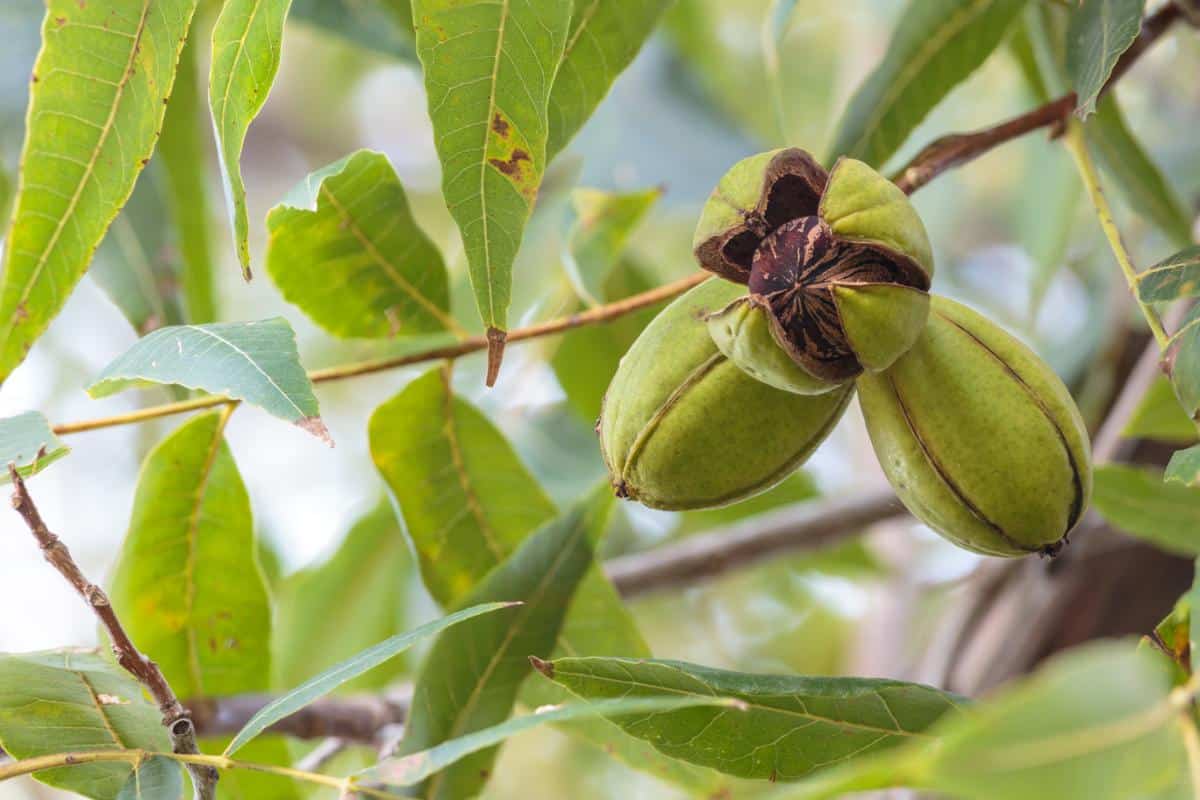
Whether you’re planting a food forest, gardening in the woods, or growing an edible garden, here are 15 nut trees that will become a valuable part of your edible landscape – and your pantry.
Jump to:
Chestnuts
These trees are a wonderful shade tree for the edible landscape but an even better source of delicious nuts.
Ripe chestnuts are enclosed in green, spiny burrs, which become sharper as the nuts ripen! The burrs eventually open, letting the chestnuts fall. Wear a hat, jacket, and gloves when gathering chestnuts so you don’t get jabbed by falling burrs.
Some burrs will jab you straight through gloves – instead, step on a burr with boots to pop them open and get the nuts out.
To enjoy chestnuts, roast them in a skillet or the oven. They can also be eaten raw – let them dry for a few days in a cool, airy place. Chestnuts will dry until they become hard. Then, they’re better used for grinding into flour. However, they can be softened by steaming them for 30 minutes.
American Chestnut

| Scientific name: | Castanea dentata |
| Recommended Varieties: | Not Recommended (yet) |
The American chestnut used to rule the eastern forests of the United States, growing to over 100 feet tall. This a giant of a tree once fed millions across the United States with sweet chestnuts. Sadly, due to chestnut blight, this giant has been laid low in the dust – but hopefully not forever.
Breeders and volunteers are working hard to create blight-resistant American chestnuts, but finding a truly resistant tree able to grow to maturity has been a difficult task. So we must leave it off the list of edible landscape trees at this time.
If you would like to take part in the effort to revive this majestic tree, the American Chestnut Foundation is spearheading this work, and those who donate to the cause can get a few seeds of newer varieties of American chestnut to grow.
European Chestnut
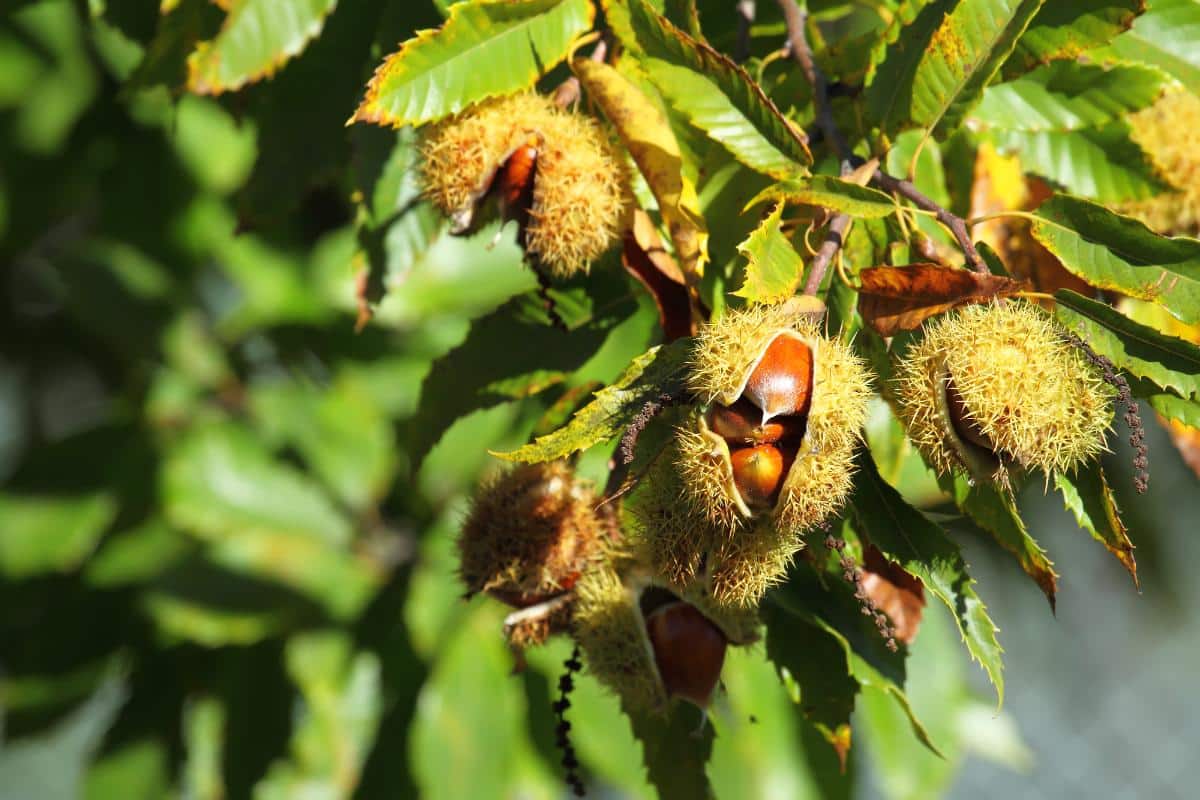
| Scientific name: | Castanea sativa |
| Also known as: | Sweet chestnut, Spanish chestnut |
| Hardiness: | Zones 5 and up |
| Size: | 40’ to 60’, occasionally up to 100’ |
| Recommended Varieties: | ‘Belle Epine,’ ‘Marrone di Marradi’ |
This chestnut came over from southern Europe, where it has it has been a favorite for thousands of years. Even back in the days of the Romans and people of antiquity, these chestnuts have been grown for food, flour, and oil.
The European chestnuts grows well in the western United States, where summers are long and mostly dry. There, chestnut blight isn’t as much of an issue, though root rot can be. These aren’t always as sweet as Chinese chestnuts, but they’re still tasty. New varieties keep improving on taste and disease resistance for the edible landscape.
Be sure to peel off the thin inner skin before eating chestnuts. It can be bitter!
Chinese Chestnut

| Scientific name: | Castanea mollissima |
| Hardiness: | Zones 4 to 8 |
| Size: | 40’, occasionally to 60’ |
| Recommended Varieties: | ‘Eaton’, ‘Orrin’ |
The eastern United States is the main domain for the Chinese chestnut. Asian chestnuts have dealt with chestnut blight for generations, so they have evolved to become mostly immune to it. Chinese chestnuts will prosper in areas with nice, warm summers, but they’re also resistant to winter cold down to -20 degrees.
A tree in full bloom is a striking part of the edible landscape, with long, light yellow catkins stealing the show in early summer. The nuts are large, sweet, and plentiful, with a flaky texture. In full sun, they are production machines, churning out chestnuts, and they are quick to produce once they’re planted.
Chinquapin
Allegheny Chinquapin
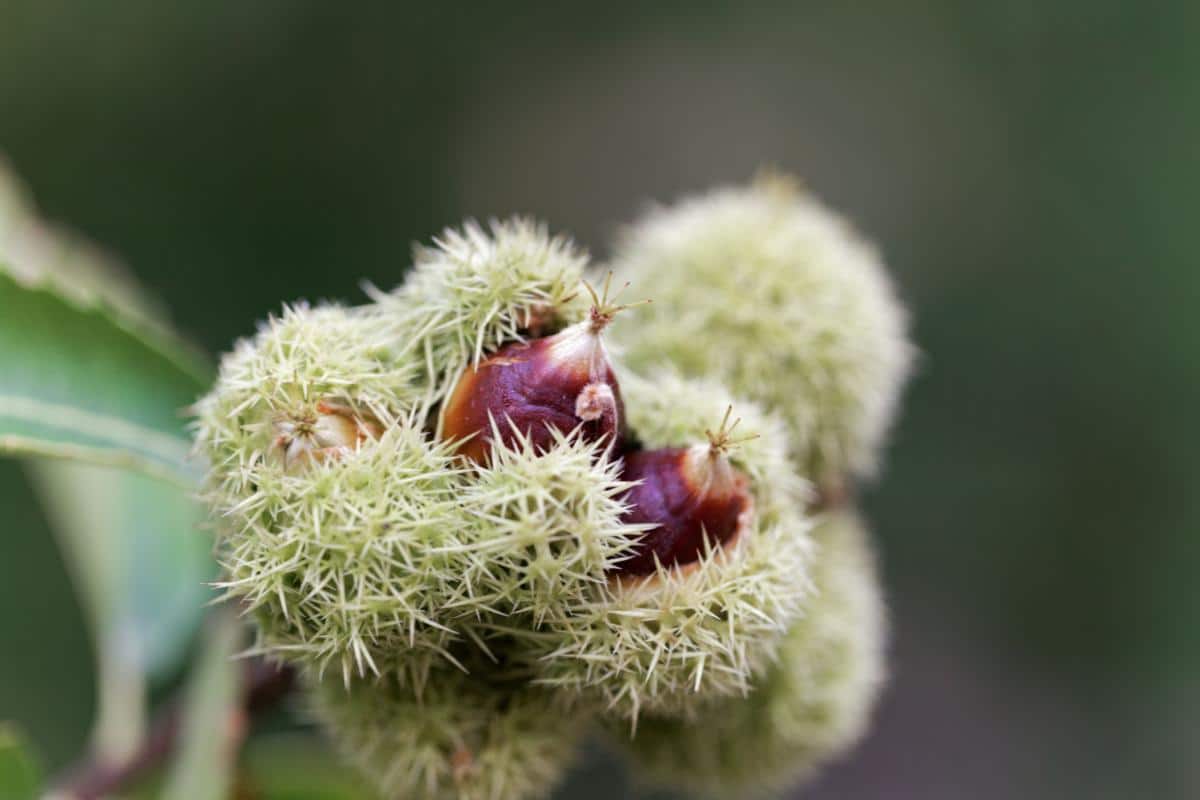
| Scientific name: | Castanea pumila |
| Also known as: | American chinquapin, common chinquapin, dwarf chestnut |
| Hardiness: | Zones 3-9 |
| Size: | 15’ to 30’ |
The Allegheny chinquapin is a dwarf tree that is somewhat resistant to chestnut blight. It bears sweet chinquapins in fall that are a favorite of both humans and wildlife.
This small tree grows up to 15 to 30 feet tall. If it gets hit with chestnut blight, it will be killed back to the roots, then springs back as a multi-stemmed shrub that forms thickets. It’s a wildlife-friendly plant, favored by deer, turkeys, squirrels, and many other animals. This chinkapin is an excellent choice for rehabilitating an area for wildlife. It’s important to include areas for wildlife when creating an edible landscape – more habitat, more wildlife, more joy.
Using fire to maintain wild areas will benefit this little chinquapin. Weeds and shade-tolerant competitors are killed off by fire, while the chinkapin sprouts vigorously and starts growing.
Beech
American Beech
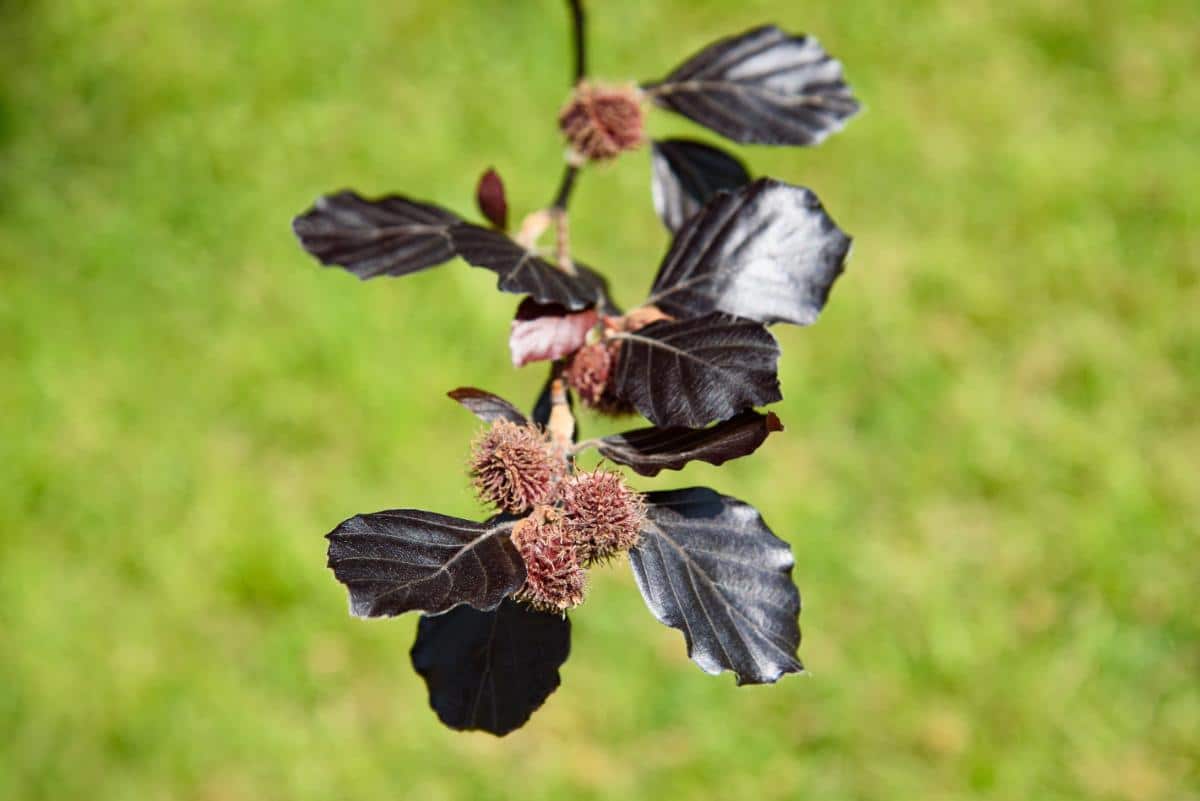
| Scientific name: | Fagus grandifolia |
| Hardiness: | Zones 3-9 |
| Size: | 50’ to 80’ |
Beeches are in the same family as chestnuts and oaks and are just as useful.
The American beech is a gorgeous, large tree with smooth grey bark, and it needs a lot of space to spread out. Beeches have wavy-cut leaves that turn golden-bronze in fall. Some beeches have dark maroon foliage, while some beech trees are variegated and absolutely gorgeous.
Beechnuts pop out of a little brown pod that looks like it’s made of Velcro. The nuts have a pleasant, sweet flavor and are chock-full of nutrients, protein, and tasty fat.
Beechnuts have been overlooked as a tasty nut for several reasons:
- They’re small!
- They taste best when eaten fresh.
- The astringent inner skin should be peeled off as well to get rid of the bitterness, a time-consuming pastime.
- Beech nuts aren’t ripe until the pods turn brown and crack open – and should be picked before the forest creatures pounce on them.
- Raw beechnuts eaten in large numbers can cause gastric distress. (Snacking on them, however, won’t lead to ill effects.) This issue is solved by roasting them.
- The biggest issue is that there’s also a difference in taste between the American beech and the European beech.
American beechnuts are sweet, while the European beechnuts are astringent and were used more for oil and livestock food. If you want beechnuts in your edible landscape, choose an American beech.
Pick beechnuts off the forest floor in mid to late fall. Rub the nuts in a towel to get rid of the Velcro-like husks, then lay the nuts in a single layer, still in the shell, to cure for a couple of weeks. After that, they can keep for years until you’re ready to eat them. Then shell them and roast them in a pan for three to five minutes until they’re fragrant.
These can also be pressed for a delicious oil with a long shelf life and tastes something like olive oil, or can be ground into flour.
Walnuts
Black Walnuts

| Scientific name: | Juglans nigra |
| Also known as: | Eastern black walnut, American black walnut |
| Hardiness: | Zones 4 to 9 |
| Size: | 50’ to 75’, occasionally reaching 150 |
Black walnut trees take a long time to grow, so you’ll be planting for future generations. Be sure to give them a lot of space – a mature tree can reach up to 120 feet tall, though many tops out at about 60 feet.
These are tough nuts to crack – literally. Here’s how my grandparents processed them.
Grandma would take us kids out with 5-gallon buckets, and we’d help her gather black walnuts that had fallen into the grass. Most were still in their powerfully aromatic green hulls. I liked how they smelled when they were fresh but not so much when the hulls turned black.
Black walnuts are easy to pop out of the husk while they’re green. Stomp lightly on a green-hulled walnut, then roll it around under your heel. The nut should pop out.
Grandpa, however, didn’t want to spend all day stomping on walnuts. He’d dump the walnuts on the gravel driveway and leave them for a few weeks to be driven over until the hulls fell off, exposing the black walnuts inside (which were impervious to tires).

In late fall we’d take an afternoon to sit at the kitchen table, cracking the walnut shells with hammers. You couldn’t hit them too hard because then the shell would be crushed into the walnut meats.
Grandpa finally got an old walnut cracker at an auction that would crack walnut shells. Then the work became easier. We’d use nutpicks to pick out the meats. Grandma would put the cleaned walnut meats into bags and store them in the freezer. Sometimes she’d put them in unsealed Mason jars and keep them in the cellar.
If you’re a real fan of black walnuts, invest in a nutcracker because cracking can be a time-intensive activity. A machine made exclusively for cracking black walnuts will help your grandparents out immensely!
We all did our best to get all the bits of walnut shells out of the meats, but we’d still find an occasional bit of shell when eating banana bread. The walnuts still tasted good.
That said, the trees grow to be pretty large. There is also a limited number of plants that can be grown under a walnut tree. Black walnuts produce a chemical called juglone from their roots that discourages growth from any competing plants.
Pawpaw trees are juglone-tolerant, and they’re a good understory plant for walnuts.
English Walnuts
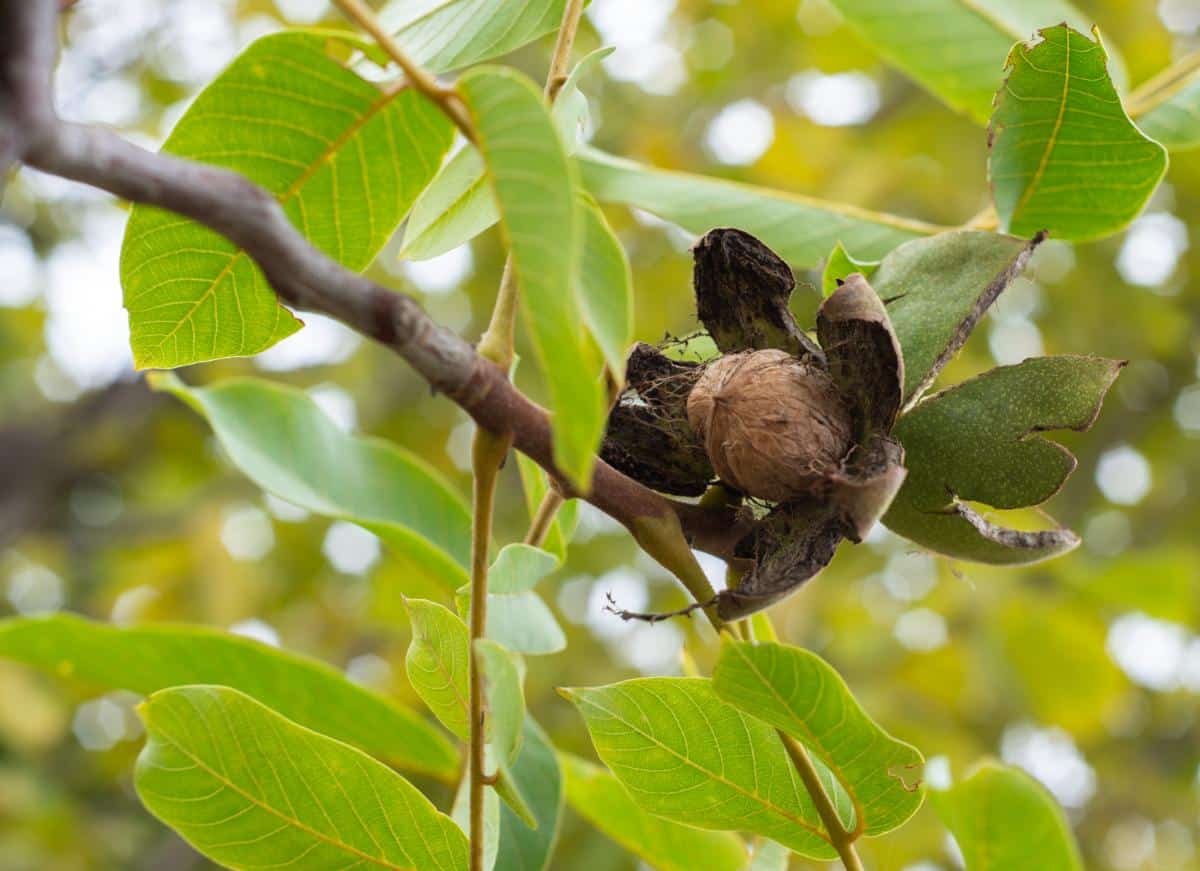
| Scientific name: | Juglans regia |
| Also known as: | Carpathian walnut, Persian walnut, Madeira walnut |
| Hardiness: | Zones 5-8 |
| Size: | 40’ to 60’ |
| Recommended variety: | ‘Fately #5’, ‘Chandler,’ ‘Carpathian’, ‘Hartley’ |
English walnut trees are native to Asia and the Balkans and do well in Europe. These are the walnuts people generally think of when it comes to cooking or buying nuts to crack from the grocery store.
English walnuts appear on the tree inside a green hull that must be removed. The walnuts from this tree are much easier to crack than black walnuts, but then again, what isn’t? They’ll bear a large harvest of delicious walnuts that are easily hulled, cured, and cracked. It’s a great tree for the edible landscape!
English walnut trees do very well in warmer areas with more moisture and grow into huge, majestic trees in old neighborhoods. It’s harder to find hardy varieties for northern climates.
Pecans
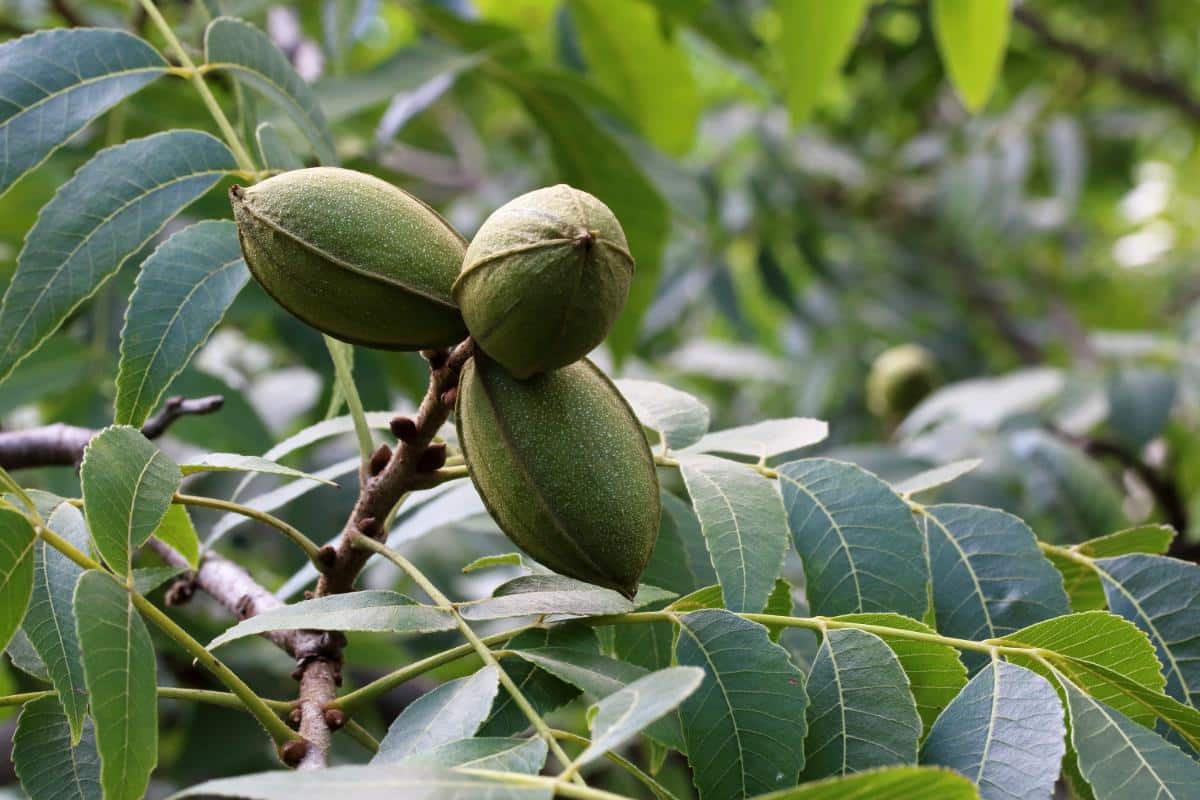
| Scientific name: | Carya illinoinensis |
| Hardiness: | Zones 5-9 |
| Size: | 70’ to 100’ |
| Recommended varieties: | ‘Caddo,’ ‘Pawnee,’ ‘Elliot’ |
The ever-popular pecan trees are a favorite in the South. People have their ears tuned to the patter of falling pecans and are outside like lightning, picking up buckets of them and occasionally fighting off hordes of squirrels that also love them!
These stately shade trees don’t need to have fancy flowers or amazing fall colors to make people love them. They merely bewitch their owners with delicious, thin-shelled nuts. Pecan trees will grow and grow and bear nuts every year. When these long-lived trees hit the century mark, they’re still bearing.
Shelling a black walnut is a fight to the end. Pecan shells pop right open if you look at them cross-eyed.
That said, pecan trees prosper in the warmer climates of the South and West. Some varieties are hardy to zones 5 and 6, but pecans need a long growing season to bring those tasty nuts to maturity.
A further fact: When it comes to pollination, there are two types of pecans.
Type I: These pecans have male catkins that shed pollen before the female flowers open.
Type II: These pecans wait for the female flowers to open before releasing pollen. Which makes more sense.
It’s important to choose trees with overlapping bloom times so pollen is released while female flowers are open, AND plant pecans within a few hundred feet of each other because they are wind-pollinated. For that reason, it’s best to plant three trees together or at least two.
Shagbark Hickory

| Scientific name: | Carya ovata |
| Hardiness: | Zones 4 to 8 |
| Size: | 60’ to 80’, occasionally reaching 120’ |
| Recommended varieties: | ‘Grainger,’ ‘J.Yoder #1’, ‘Porter,’ ‘Selbhers,’ ‘Simpson #1’, ‘Mitch Russell’ |
Hickories are a classic part of American forests. In fact, the mature oak-hickory forests so common in the eastern and midwestern United States may have been grown and maintained by Native Americans. They used fire to maintain this fruitful mix of trees while subduing the fire-sensitive interlopers that would try to take over forests. The acorns from oak trees were necessary for survival and would attract food animals such as turkey and deer, as the hickory nuts were.
Hickory nuts are often overlooked because people strolling through the woods will find a few sad, bug-eaten nuts or find that the nutmeats don’t always fill the shell.
However, good hickory nuts taste like sweet, buttery pecans. They are cousins to the pecans, after all.
Here’s how to find the good hickory nuts. After removing the hulls, drop the nuts in a bucket of water.
Keep the nuts that sink to the bottom. Those are ripe and good.
The ones that float are bad – bug-ridden, moldy, or malformed. Get rid of those.
Then let the nuts cure for two or three months by setting them in a cool, dark place. This is important! Letting the nut dry will make it easier to break the shells and extract whole meats.
When it comes time to crack the nuts, use a pair of wire clippers to snip off the pointy end of the shell, then cracking becomes much easier.
Roasting the nutmeats in the shell might make them easier to remove, and they’re even tastier. Put the unshelled hickory nuts in the oven for about 2 hours at 200 degrees F.
If you like pecan pie, try hickory nuts instead. You’ll be pleasantly surprised!
There’s an early fall of green hickory nuts in summer as the tree drops insect-damaged nuts. If you have a smoker, use these nuts as wood to add great flavor to pork and fish. You can add the shells of cracked nuts as well.
Hickory trees can take a long time to produce nuts, so look for grafted hickories. These generally mature and bear nuts in half the time.
Hazelnuts
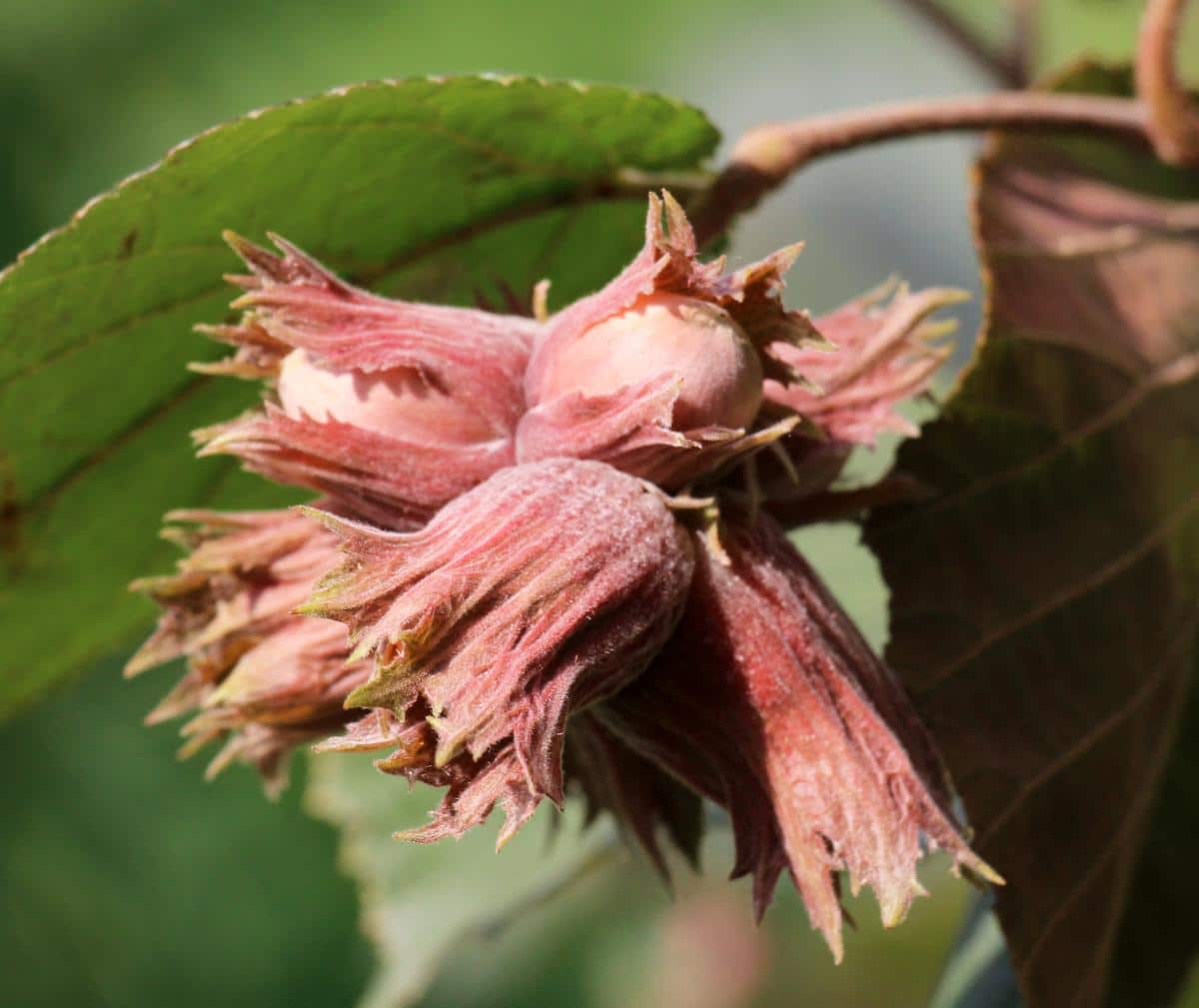
| Scientific name: | Corylus spp. |
| Also known as: | Filberts, Hazel |
| Hardiness: | Zones 4 to 9 |
| Size: | 10’ to 20’ |
Hazelnuts are grown on large shrubs that are generally decimated by squirrels before I can get to them. This seems to be a recurring theme in my life. Since they’re shrubs, you won’t have to wait long for them to bear nuts. One hazelnut shrub or tree might produce anywhere from 5 to 20 pounds of nuts.
Hazelnut bushes make a good screen or hedge because they tend to sucker, so you can grow them along the property line.
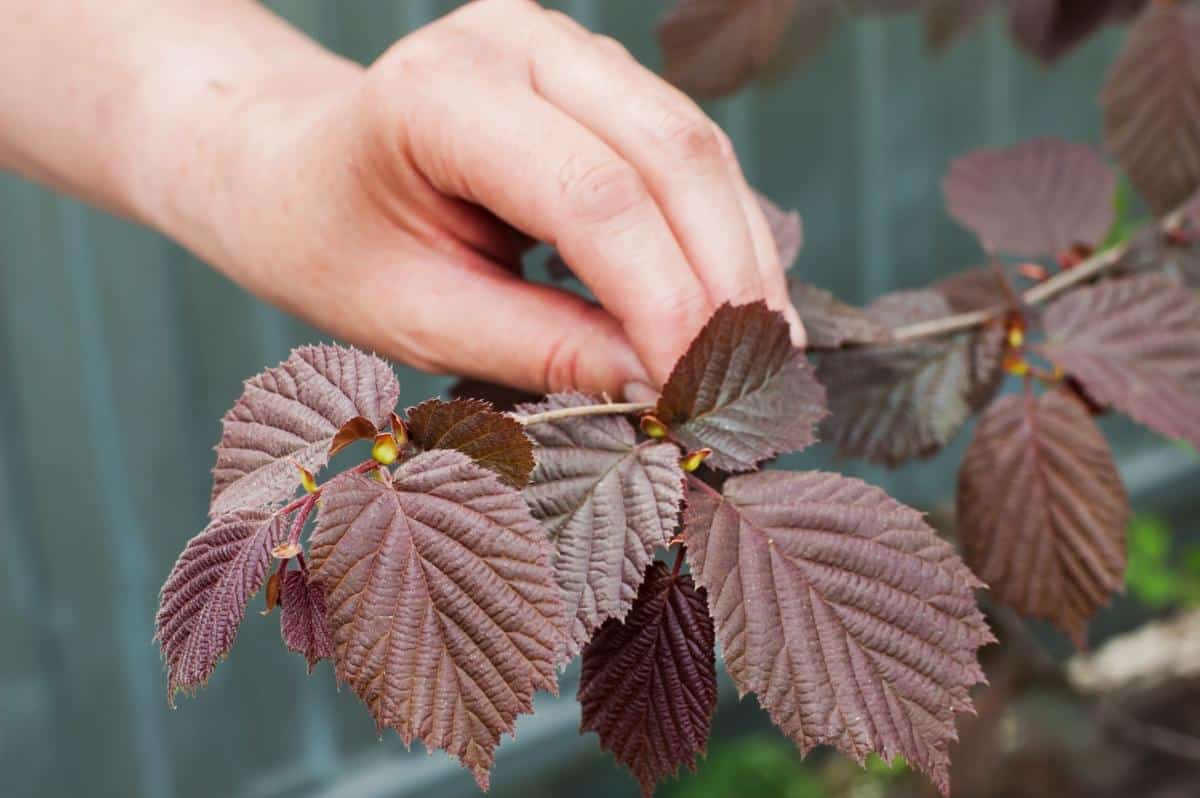
A number of hazelnut varieties and cultivars are grown for their colored foliage or contorted stems, and they look very attractive. Others are grown mainly for nut production.
- American hazelnut (Corylus americana) will self-pollinate, but they bear smaller hazelnuts overall in the edible landscape. This native species is blight tolerant.
- European hazelnut ( avellana) requires another pollinator for best results. These bear larger nuts than the American species. However, in some areas of the country, the Eastern filbert blight will kill off European hybrids.
- Chinese hazelnut ( chinensis) needs much more space than the little shrubs. This hazel becomes a humongous tree, growing up to 80 feet tall!
- Beaked hazelnut ( cornuta) is a native species that grows best in moist, well-drained sites, as well as in open forests and forest edges. The nuts are about the size of a penny.
- Purple-leaved filbert ( maxima ‘Purpurea,’) is one of many purple-leaved varieties. It features deep maroon, almost black foliage, and also bears delicious hazelnuts. It’s hardy to zone 4 and has some yellow fall color.
- Anny’s Purple Dream Hazel (C. avellana ‘Anny’s Purple Dream’) has dark maroon foliage and is grown more for foliage than hazelnuts.
- Harry Lauder’s Walking Stick (C. avellana ‘Contorta’) This popular landscape shrub is mainly grown for its contorted corkscrew branches, which look striking in the landscape especially in winter. It will bear hazelnuts, but they’re more of an afterthought.
Several Things to Remember in Harvesting Nuts
Here are a few rules of thumb to make your harvest easier and successful.
- After gathering nuts, dump them into a bucket of water. Get rid of the floating nuts – and keep the ones that sink.
- Remove the hulls, then let them cure in the shell for a few months. This gets rid of excess moisture and allows them to mellow. Tannins will fade, and the nuts will become sweeter.
- After curing, the shell is easier to crack, and the nutmeats should slide out more easily.
- As far as harvests, nut trees go through mast years. A mast year is when the tree bears an unusually large number of nuts. Then, they have three, five, or seven years of light harvests before having another mast year. So, if your tree doesn’t seem to be producing, give it a few years.
Conclusion
This article only scratches the surface of good nut trees to grow in your yard. Some of these trees can live centuries, while others are just friendly little shrubs. They are all valuable parts of the landscape, adding to the beauty of your edible landscape while bearing healthy snacks for your table.
By Rosefiend Cordell, horticulturist.

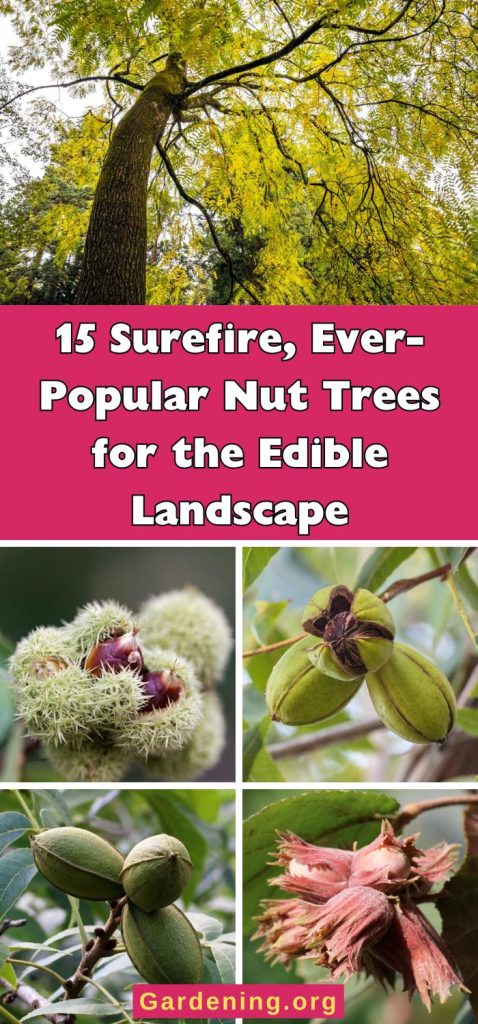

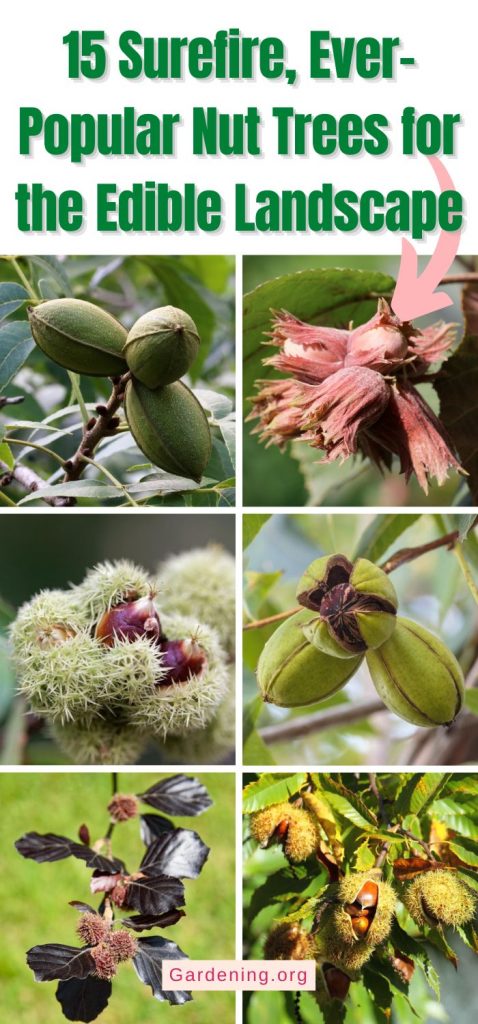
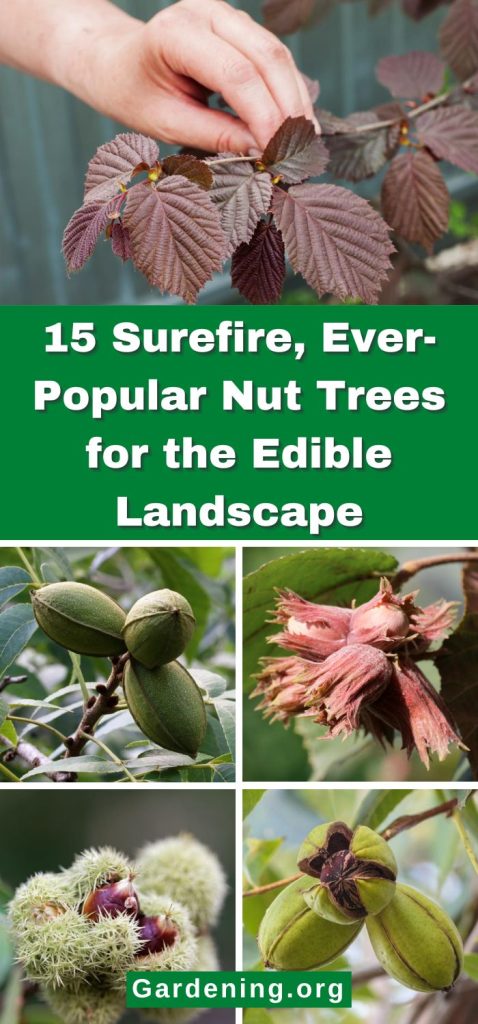
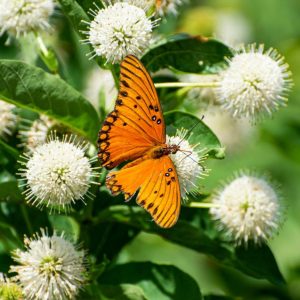
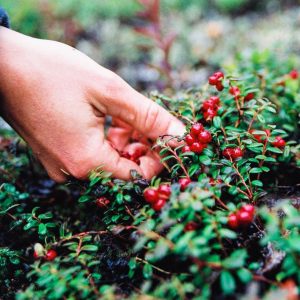


Leave a Reply